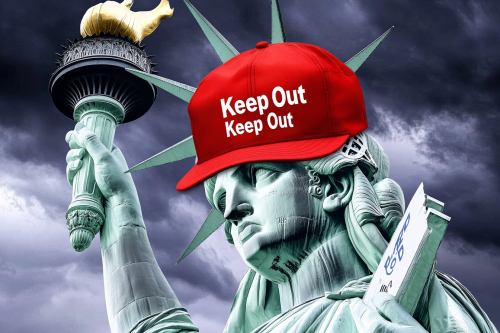The most recent data available shows that the US, E-1 Treaty Trader visa and E-2 Treaty Investor visa bring four times more immigrants into the US than the much publicised EB-5, immigrant investor program, according to the Center for Immigration Studies [CIS] - an anti-immigration research organization. While the CiS is an anti-immigration organisation their report despite containing numerous inaccuracies is actually quite interesting.
Based on data from the US Department of State's Report of the Visa Office for 1994 through 2013, the Center for Immigration Studies says that the E-1 Treaty Trader and E-2 Treaty Investor programs provided non-immigrant visas for more than 42,000 foreign nationals in 2013.
In a report published by the CIS, the research organization said: "While there have been news stories and congressional hearings on EB-5 visas (the immigrant investor program), the roughly comparable E-1 Treaty Trader and E-2 Treaty Investor visas that bring in about four times as many aliens has drawn virtually no attention." It should be noted that the EB-5 immigrant investor program is a permanent residence category whereas the E-1 and E-2 visa schemes are temporary visas that can continue to be extended as long as the business continues in the US.
Sanwar Ali, Editor or workpermit.com News had the following to say:
The Center for Immigration Studies report does contain a number of inaccuracies. It seems to suggest that the E-2 Treaty investor visa and E-1 Treaty trader visa are easy to obtain. This is not true. It is a complicated process. You need to provide convincing evidence that you have invested and put money at risk and usually need to create jobs. There is a lot of documentation required to convince a visa officer to firstly grant E-2 or E-1 registration to the business and then a visa.
Huge increase in EB-5 Immigrant Investor visas in recent years
The CIS asserts that not that many years ago the number of EB-5 immigrant investor visas granted amounted to hundreds not thousands. However – according to CIS due to huge backing from President Obama's administration – the number is now at the quota level of 10,000 visas per year. The CIS also says that the E-1 and E-2 programs have 'no numerical ceiling' which is actually true.
According to the CIS, the E-1 and E-2 treaty visas, unlike the EB-5 program, are 'operated by the US Department of State, requiring minimal interaction with US local business organizations or US government agencies at any level.' This is not really true. Usually you apply at your nearest US Embassy or Consulate. This is obviously a Government Agency. Also, these days more and more checks are done by various Government Agencies.
The CIS says that if a foreign national fits the US Department of State's 'image of a treaty trader or investor', then the foreign national will be issued with a visa following an overseas interview. While it's possible to secure an adjustment to E-1 or E-2 status in the US, the resulting document does not permit a visa holder to leave and re-enter the country. This information provided by CIS is clearly wrong. It is difficult to obtain E-1 or E-2 treaty registration.
The CIS claims that the E-1 and E-2 visa renewal process represents the only form of management of the program saying that: "Every two years the visas have to be renewed, but as long as the State Department regards the business as 'substantial' there is no limit on the number of renewals." Again this is not entirely true. E-1 and £-2 registration and visas can be issued for longer periods of time such as five years.
This causes three main concerns with the E-1 and E-2 visas according to the CIS, including:
- There being absolutely no oversight of the foreign nationals involved within the United States.
- There being no numerical ceiling on the number of visas that can be issued.
- There being no limit on what's considered an appropriate amount of money to invest.
By contrast, the CIS says that 'the fraud-ridden EB-5 program actually looks to be a more responsible program in comparison to E-1 and E-2 visas.'
Points one and three above are misleading. As with other businesses in the US you have to comply with numerous laws relating to tax, employment, etc. In practice it is difficult to meet the E-2 substantial investment requirement. It is not easy to tell how much is actually required to show substantial investment. The laws are also quite complicated and difficult to understand.
E-1 Treaty Trader and E-2 Treaty Investor Visa Requirements
The E treaty visa program is split into two subcategories, E-1 treaty traders and E-2 treaty investors. E-1 treaty trader visas are issued to foreign nationals, along with their family members and employees, whose business is engaged in substantial trade between the US and is the less popular of the subcategories. E-2 treaty investor visas are for treaty investors who have made a substantial investment in their US business, along with their family members and employees.
For both the E-1 and E-2 visa programs, foreign national entrepreneurs, and spouses, after applying for employment authorisation, can work. "Exexcutive and Supervisory" and "Essential or special skilled" employees can apply for E-1 and E2 work visas for the US. However, children passing their 21st birthday will no longer meet the requirements under E-1 or E-2 so they must either leave the US or switch to another visa status, such as the F-1 visa for students or perhaps even an E-1 or E-2 employee visa.
The reports states that E-1 Treaty traders tend to enter the US for the purposes of representing international corporations, while E-2 treaty investors tend to operate their own companies in the US. However, it has to be said that many if not most companies whether or not they are international companies will have difficulties meeting the substantial trade requirement for the E-1 treaty trader visa.
E-2 Treaty Investor Visa more popular than E-1 Treaty Trader Visa
Over the last 20 years, the E-1 visa category has become less popular and the E-2 visa category much more popular according to data compiled based on numerous reports issued by the US Department of State between 1994 and 2013.
Based on the number of visas issued, statistics show that the E-1 treaty trader category dropped from around 11,000 visas per year during the mid-1990s to 6,000 or 7,000 in more recent years. In contrast, the E-2 treaty investor category saw a sharp rise from 19,000 visas per year in the 1990s, up to more than 35,000 in 2013.
In 2013, State Department data shows that Germany was the greatest recipient of E-1 visas [1,317] and E-2 [3,811] visas in Europe. Across the Asian regions, Japan topped the list, receiving 1,625 E-1 visas and 11,333 E-2 visas, while Mexico received the most across the North and Central American regions with 1,198 E-1 visas and 3,001 E-2 visas.
Australia topped the list for the Oceania region with 40 E-1 visas and 313 E-2 visas, while Columbia received the most E-1 visas [70] for the South American regions, with Argentina receiving 310 E-2 visas.
Globally, the US has treaties of commerce and navigation agreements in place with 80 countries. 54 nations have been approved for both E-1 treaty trader and E-2 treaty investor visas, while the remaining 26 have been approved for E-2 treaty investor visas only.
CIS claims Obama administration heavily promotes Immigrant Investor EB-5 program
According to the CIS, the Obama administration has been heavily promoting the EB-5 program in ways that it describes as 'highly questionable' We do not quite understand what CIS means by this. CIS claims that with the E-1 and E-2 visa program not much has changed with no new treaties having been agreed since 2008. It also has to be said that the EB-5 immigrant investor program has not changed.
The CIS says that growth in the number of E-1 and E-2 visas issued has come as a result of granting more visas to those nations already involved in the program, with some of those agreements put in place back in the 19th Century.
The CIS describes the E-1 and E-2 treaties as 'reciprocal in nature', given that they provide US business people with the same rights in treaty nations as the nationals of other countries enjoy in the US. Again this is misleading. It seems that US citizens typically do not benefit from similar business based visa schemes with other Countries on a reciprocal basis.
The CIS says that treaty agreements are usually made with other prosperous nations. They say that there are very few low-income countries are on the list; this is not actually true. There are plenty of low income Countries on the list. However, perhaps not many applications from nationals of these Countries. Also, the two Countries with the largest populations China and India do not feature on the E-1 and E-2 treaty visa list.
The CIS says that as the Chinese are unable to access the E-1 and E-2 visa programs this explains, to some extent, why the EB-5 program has seen increased interest from rich Chinese nationals.




